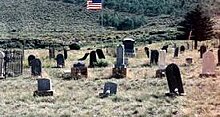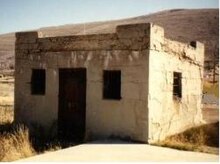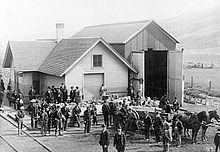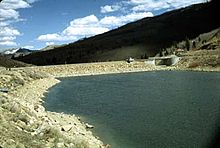Scofield, Utah
Scofield, Utah | |
|---|---|
 Historic Scofield Utah School building | |
Location of Scofield, Utah | |
| Country | United States |
| State | Utah |
| County | Carbon |
| Founded | 1879 |
| Named for | Charles W. Scofield |
| Area | |
| • Total | 0.5 sq mi (1.3 km2) |
| • Land | 0.5 sq mi (1.3 km2) |
| • Water | 0.0 sq mi (0.0 km2) |
| Elevation | 7,739 ft (2,359 m) |
| Population (2000) | |
| • Total | 28 |
| • Density | 55.9/sq mi (21.6/km2) |
| Time zone | UTC-7 (Mountain (MST)) |
| • Summer (DST) | UTC-6 (MDT) |
| ZIP code | 84526 |
| Area code | 435 |
| FIPS code | 49-67990Template:GR |
| GNIS feature ID | 2413267[1] |
Scofield is a town in Carbon County, Utah, United States. The population was 28 at the 2000 census. Scofield's name is frequently applied to the 1900 mine disaster in the Pleasant Valley Coal Company's Winter Quarters mine. The community was named for General Charles W. Scofield, a timber contractor and local mine official.
History

The town of Scofield is situated on high ground two miles south of the reservoir of the same name, the oldest and largest of the major impoundments on the Wasatch Plateau. Once the most populous community in Carbon County, Scofield has shrunk to only a few permanent residents. What has slowed the continual decline has become outsiders constructing summer vacations homes. The old brick school stands empty at the upper end of town and there are abandoned buildings scattered through what was once the business district. Only the cemetery on a hill to the east suggests that this was once a community of some size. Visitors to the cemetery quickly become aware of the diverse ethnicity that populated the town.[2]
Settlement
The luxuriant growth of the native grasses indigenous to this region, this valley was first utilized as pastures for the immense herds of cattle that came from Utah Valley. Among the first settlers of this region were S. J. Harkness, T. H. Thomas, William Burrows, O. G. Kimball, D. D. Green, A. H. Earll, R. McKecheney who were attracted by the immense ranges for their cattle.[3]
Discovery of Coal and Coming of the railroad
Coal was discovered in the valley in 1875 and two years later, a small mine was opened on the western slopes of the canyon and the coal was transported out along narrow roads. The winter of 1877 came early and was very severe, stranding the miners in the coal pit and keeping them snowbound until the following February. The ordeal led the miners to name their forced camp “Winter Quarters” and this became one of the first commercial coal mines in the state. Most the first miners at the Winter Quarters were Mormon converts from the coal districts of Wales, England and Scotland. One of them, David Williams, leased the Winter Quarters Mine from the Pleasant Valley Coal Company from 1880 to 1885, operating in the dual capacity of mine manager and bishop of the local LDS Ward. When the Rio Grande Western railroad acquired the coal company, they undertook the development of a new mine on Mud Creek, a mile from Winter Quarters, much to the chagrin of Williams, who protested that the new mine infringed on his lease. Because Bishop Williams controlled the Mormon miners, the Pleasant Valley Coal Company brought in Chinese laborers to work the Mud Creek mine. Soon a large contingent of Finns were recruited, along with Italian, Greek, and other Scandanavian workers.[2]
As coal veins commenced to be worked, it was not long before the discoverers found out that the supply seemed inexhaustible. The railway companies finding that the coal fields were of such magnitude and covered so much territory, began to survey for practicable routes to reach the coal. The route through Spanish Fork Canyon was finally decided upon, and a narrow gauge was built into Scofield. Before the railroad was completed, winter set in and the last few miles, were laid upon the ice and snow as it was impossible to find the ground due to the snow drifts . The Coal Company known as the Union Pacific Coal Company claimed all of the land on the town site, and those building a home were compelled to lease the spot of ground desired from this Company. Not knowing how long they would be permitted to remain as laborers in the mines, the men did not build elaborate homes as they knew that should the work cease, they would be compelled to sacrifice their homes. Log cabins were the order of the day, and as lath and plaster was out of reach on account of high prices. The Union Pacific still continued to collect their ground rent, and the knowledge that the miners had of the company that was ruling the camp at that time deterred them from beautifying their homes as they desired.

However, this state of affairs was not to continue for long, as the rights of the Company to hold the land become to be questioned. Part of their land was jumped and their title was found to be imperfect, in fact they had no title whatever to the land now incorporated in the townsite. The business district was more than a mile long and boasted dozens of substantial stone buildings, including an Odd Fellows Hall.[3] As the mine and the community grew, new and more efficient methods were sought to move the coal from the mines and so the Utah & Pleasant Valley Railroad was constructed, running from Springville to Winter Quarters and Scofield. It connected with the Denver & Rio Grande line in Colton, Utah which was about 20 miles away. [2]
In 1882, the Utah Fuel Company took over the mine and town and it soon became a subsidiary of the Denver & Rio Grande Railroad. The region continued to thrive until 1900, when there were several hundred men in the mines and residents that numbered as high as 1,800. The mine was considered to be the safest in the region and according to reports, was free from the gases that plagued so many other coal operations.
Disaster

On May 1, 1900, an errant spark touched off the fine haze of coal dust deep underground and the Winter Quarters #4 mine exploded with fury (See Scofield Mine disaster). Exactly 100 of the men were killed in an instant and another 99 died from the poisonous afterdamp, making this one of the worst coal mine disasters in history. That one moment of time left 105 widows and 270 fatherless children behind.. Almost 150 of the slain miners were buried in the cemetery in nearby Scofield and two special funeral trains carried the rest of the victims to burial grounds in Utah and in other states.
Decline
On May 28, just four weeks after the disaster in Number Four, coal mining resumed at Winter Quarters. While some of those who had escaped the explosion left the area for other work, many others returned to the mines. The dead were soon replaced, through production evidently suffered somewhat from the loss of more experience miners. Despite declining profitability, the Winter Quarters mines continued to operate until the 1930s. The tipple and other large structures were dismantled for their salvage value during World War II; the chapel and the boarding house were leveled.[2]
Scofield, sustained by several mines in Pleasant Valley, was still the largest town in Carbon County in 1915, when its citizens made an attempt to have the county seat moved to their community from Price, Utah. By the 1920s, however, the coal industry in Pleasant Valley was clearly in decline and most mines ceased operation causing the town to lose nearly all its residents.
Geography
Scofield is located at 39°43′36″N 111°9′37″W / 39.72667°N 111.16028°WInvalid arguments have been passed to the {{#coordinates:}} function (39.726703, -111.160396)Template:GR.
According to the United States Census Bureau, the town has a total area of 0.5 square miles (1.3 km²), all of it land.
The town of Scofield, lies in the bituminous coal field of Carbon County, Utah, about nineteen miles from the main line of the Rio Grande Western Railroad, and is nestled among the hills that surround the upper part of Pleasant Valley. Fish Creek enters the valley about two miles below Scofield, and is one of the head waters of the Colorado River System. Clear Creek and the waters of the Winter Quarters creek unite at the south end of town and flow through the valley until junctioning with Fish Creek.[3]
Famous residents
- Robert David Mullins Pulitzer Prize-winning journalist, was born in Scofield on December 16, 1924.
- Boyd McAffee -summer camp leader, was born on June 1949.
Demographics
As of the censusTemplate:GR of 2000, there were 28 people, 12 households, and 9 families residing in the town. The population density was 55.9 people per square mile (21.6/km²). There were 78 housing units at an average density of 155.6/sq mi (60.2/km²). The racial makeup of the town was 100.00% White.
There were 12 households out of which 25.0% had children under the age of 18 living with them, 66.7% were married couples living together, 8.3% had a female householder with no husband present, and 16.7% were non-families. 16.7% of all households were made up of individuals and 8.3% had someone living alone who was 65 years of age or older. The average household size was 2.33 and the average family size was 2.50.
In the town the population was spread out with 14.3% under the age of 18, 10.7% from 18 to 24, 25.0% from 25 to 44, 28.6% from 45 to 64, and 21.4% who were 65 years of age or older. The median age was 45 years. For every 100 females there were 75.0 males. For every 100 females age 18 and over, there were 100.0 males.
The median income for a household in the town was $26,250, and the median income for a family was $28,750. Males had a median income of $26,250 versus $14,375 for females. The per capita income for the town was $10,764. There were no families and 9.1% of the population living below the poverty line, including no under eighteens and none of those over 64.
Although the number of people living in Scofield is low, many own cabins, summer and winter homes, and fishing shacks around Scofield Reservoir. There is also a state park located by the lake.
Scofield State Park

Scofield State Park is situated just east of Scofield Reservoir and has 3 different camping areas: Mountain View, Madsen Bay, and Lake Side. Mountain View is a 34-unit campground that includes rest-rooms, heated showers, fish cleaning and disposal stations, a group use pavilion, a boat launching ramp and rental boats. Madsen Bay is a 40 unit campground with rest-rooms, fish cleaning and disposal areas a boat ramp and parking for day use. Lake Side has no camping areas but is strictly day use and offers rest-rooms, a group use pavilion and a fishing platform for the disabled.
Clear Creek Summer Camp
The Clear Creek Summer Camp program is an outdoor education, located 2 miles south of the town of Scofield experience for post-fifth grade students in the Alpine School District. Each summer, Clear Creek Camp hosts approximately 1,100 students. The summer camp experience is designed to educate students about the outdoors and help foster a deep appreciation for the abundant natural resources and beauty in our surroundings. The camp gets its roots from an outdoor education program held at Central Elementary School in the 1940's. Between 1940 and the 1960's, the program eventually grew to be so successful that a summer camp was requested. It was held at various locations for many years, including the city of Clear Creek from which it is name. After being there for a few years, property became available from Questar (then Mountain Fuel) with 6 cabins and a multi-purpose facility in 1973. The facilities was ready to use for groups of students in 1974 and Alpine School District has used the same grounds since then.
See also
References
- ^ a b U.S. Geological Survey Geographic Names Information System: Scofield
- ^ a b c d Geary, Edward A. (March 12, 2002). The proper edge of the sky: the high plateau country of Utah. University of Utah Press. ISBN 0874804094.
- ^ a b c Dilley, James W. History of the Scofield mine disaster.
External links
![]() Media related to Scofield, Utah at Wikimedia Commons
Media related to Scofield, Utah at Wikimedia Commons

